Watched December 24-30, 2007 (part two): Murnau, Honda and Burton
Nosferatu, eine Symphonie des Grauens / Nosferatu, a Symphony of Horror (F.W. Murnau, 1922)
 The old Kino DVD of this film actually looked quite good (far better than older versions I had seen) but, though it had two musical scores, neither struck me as satisfactory. The new Kino DVD looks better --
The old Kino DVD of this film actually looked quite good (far better than older versions I had seen) but, though it had two musical scores, neither struck me as satisfactory. The new Kino DVD looks better --  and, perhaps more important, sounds vastly better, thanks to the reconstructed, newly recorded, original (1922) score of Hans Erdmann. This version of Nosferatu, or its British cousin (from Masters of Cinema), is an indispensable one for fans of Murnau and of "silent" cinema in general.
and, perhaps more important, sounds vastly better, thanks to the reconstructed, newly recorded, original (1922) score of Hans Erdmann. This version of Nosferatu, or its British cousin (from Masters of Cinema), is an indispensable one for fans of Murnau and of "silent" cinema in general.
 This is one of my favorite silent films (and one of my two favorite Murnau films, along with Last Laugh). The cinematography by Fritz Arno Wagner is, to my mind, unsurpassable. While the acting style is florid here, it certainly suits this material.
This is one of my favorite silent films (and one of my two favorite Murnau films, along with Last Laugh). The cinematography by Fritz Arno Wagner is, to my mind, unsurpassable. While the acting style is florid here, it certainly suits this material. 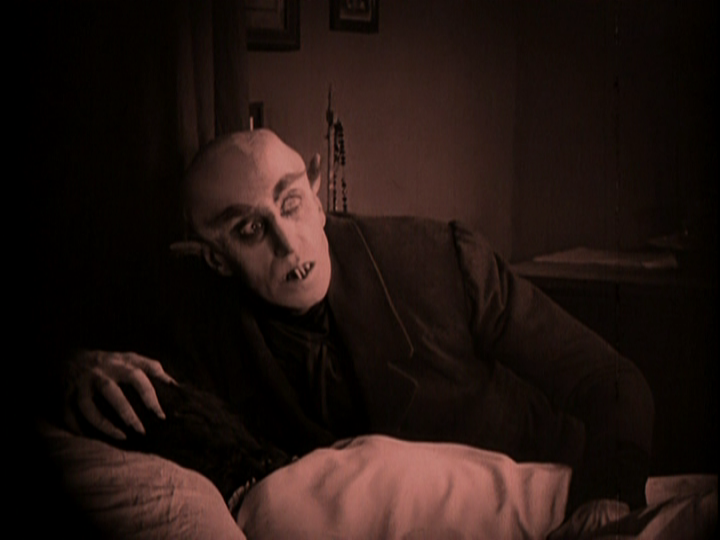 So much has been written about this film that any brief comments I can offer are essentially superfluous, however. More important by far are screen shots -- which I hope convince anyone who lacks a new improved version of this classic to rent or borrow a copy -- or better yet, buy one.
So much has been written about this film that any brief comments I can offer are essentially superfluous, however. More important by far are screen shots -- which I hope convince anyone who lacks a new improved version of this classic to rent or borrow a copy -- or better yet, buy one.
http://i9.photobucket.com/albums/a59/mkerpan/murnau/nos/nos01.png
http://i9.photobucket.com/albums/a59/mkerpan/murnau/nos/nos02.png
http://i9.photobucket.com/albums/a59/mkerpan/murnau/nos/nos03.png
http://i9.photobucket.com/albums/a59/mkerpan/murnau/nos/nos04.png
http://i9.photobucket.com/albums/a59/mkerpan/murnau/nos/nos05.png
http://i9.photobucket.com/albums/a59/mkerpan/murnau/nos/nos06.png
http://i9.photobucket.com/albums/a59/mkerpan/murnau/nos/nos07.png
http://i9.photobucket.com/albums/a59/mkerpan/murnau/nos/nos10.png
http://i9.photobucket.com/albums/a59/mkerpan/murnau/nos/nos11.png
http://i9.photobucket.com/albums/a59/mkerpan/murnau/nos/nos12.png
http://i9.photobucket.com/albums/a59/mkerpan/murnau/nos/nos13.png
http://i9.photobucket.com/albums/a59/mkerpan/murnau/nos/nos14.png
http://i9.photobucket.com/albums/a59/mkerpan/murnau/nos/nos16.png
http://i9.photobucket.com/albums/a59/mkerpan/murnau/nos/nos17.png
http://i9.photobucket.com/albums/a59/mkerpan/murnau/nos/nos18.png
Matango / Attack of the Mushroom People (Ishirô Honda, 1963)
Perhaps it was unfair to Mr. Honda to watch his Matango the same week that I watched the newly restored Nosferatu. His (very loose) adaptation of William Hope Hodgson's 1907 story "The Voice in the Night" is certainly one of the best of Japan's vintage science fiction films of the 1950 and 1960s. And yet, Matango is not really competitive with the older "horror" film -- or with the story that inspired it.
His (very loose) adaptation of William Hope Hodgson's 1907 story "The Voice in the Night" is certainly one of the best of Japan's vintage science fiction films of the 1950 and 1960s. And yet, Matango is not really competitive with the older "horror" film -- or with the story that inspired it.
Hodgson's story is simple but eloquent and narrowly focussed on telling its "incredible" story in a believable fashion.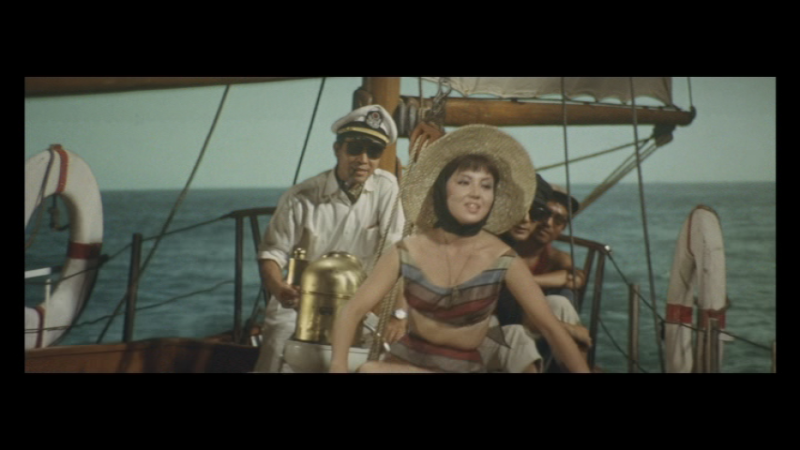 Hodgson tells of a ship, becalmed in the North Pacific, that encounters a man in a small boat, begging for food for himself and his wife. The man refuses to allow himself be seen clearly -- or to come on board the ship. At first suspicious, the crew decides to provide the help he requested,
Hodgson tells of a ship, becalmed in the North Pacific, that encounters a man in a small boat, begging for food for himself and his wife. The man refuses to allow himself be seen clearly -- or to come on board the ship. At first suspicious, the crew decides to provide the help he requested, 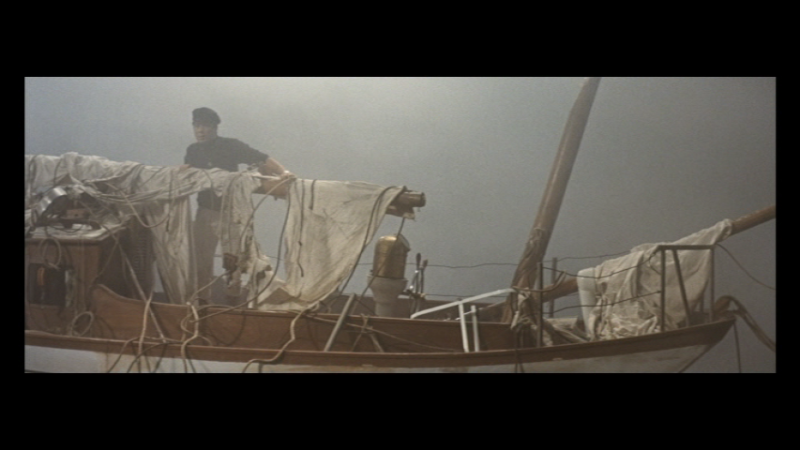 stirred by the urgency and sincerity of his tone. Food having been floated over to the man, he rows back to the isand where he and his wife are standed. Hours later, the man returns. He expresses gratitude and tells them that the two of them agreed that he should recount the story of their misfortunes.
stirred by the urgency and sincerity of his tone. Food having been floated over to the man, he rows back to the isand where he and his wife are standed. Hours later, the man returns. He expresses gratitude and tells them that the two of them agreed that he should recount the story of their misfortunes.
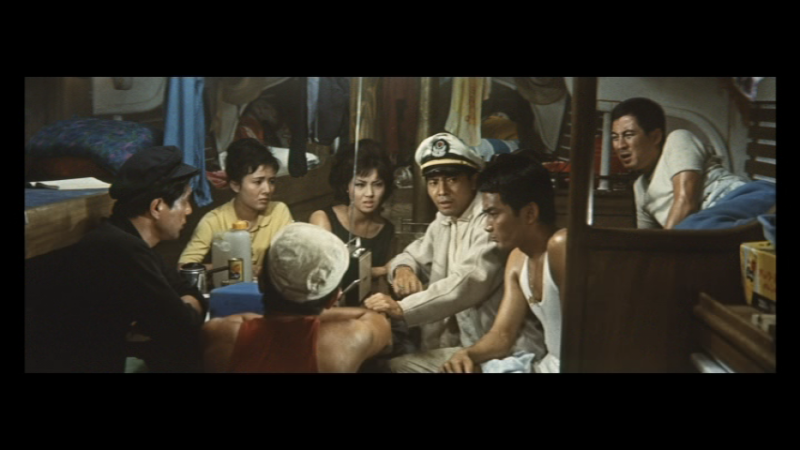 The two were abandoned as the result of a shipwreck, left behind by the crew due to an insufficient supply of life boats. They floated (on a raft they made) to an island, but the island was almost entirely covered by some sort of lichenous growth -- lacking any sort of normal vegetation or animal life.
The two were abandoned as the result of a shipwreck, left behind by the crew due to an insufficient supply of life boats. They floated (on a raft they made) to an island, but the island was almost entirely covered by some sort of lichenous growth -- lacking any sort of normal vegetation or animal life.  They found a stranded ship offshore, but it too had been taken over by the lichenous growth -- and proved to be uncleanable. Luckily, they found a tiny patch of sandy beach that seemed resistent to the spread of the growth, but they still lacked a source of food (other than the supplies they had brought along and some canned good they found on the abandoned ship). Despite their best efforts to avoid contact with the lichenous contamination, they found that tiny patches of lichen had begun to appear on their skin. When returning from fishing one day (with little to show for his efforts),
They found a stranded ship offshore, but it too had been taken over by the lichenous growth -- and proved to be uncleanable. Luckily, they found a tiny patch of sandy beach that seemed resistent to the spread of the growth, but they still lacked a source of food (other than the supplies they had brought along and some canned good they found on the abandoned ship). Despite their best efforts to avoid contact with the lichenous contamination, they found that tiny patches of lichen had begun to appear on their skin. When returning from fishing one day (with little to show for his efforts), 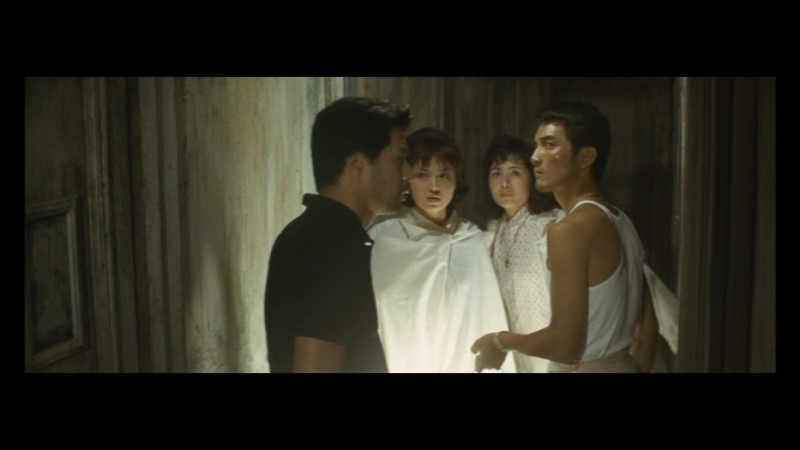 he found his wife had tried eating fungus due to her dire hunger. While wandering long a path through the island's "forest", he encountered a strange creature that seemed to be almost entirely made of fungus -- and realized the ultimate fate that awaited his wife and himself, if they were to continue eating the lichenous growth. The couple had resolved not to eat any more of the apparently addictive substance, but had now run out of food.
he found his wife had tried eating fungus due to her dire hunger. While wandering long a path through the island's "forest", he encountered a strange creature that seemed to be almost entirely made of fungus -- and realized the ultimate fate that awaited his wife and himself, if they were to continue eating the lichenous growth. The couple had resolved not to eat any more of the apparently addictive substance, but had now run out of food. 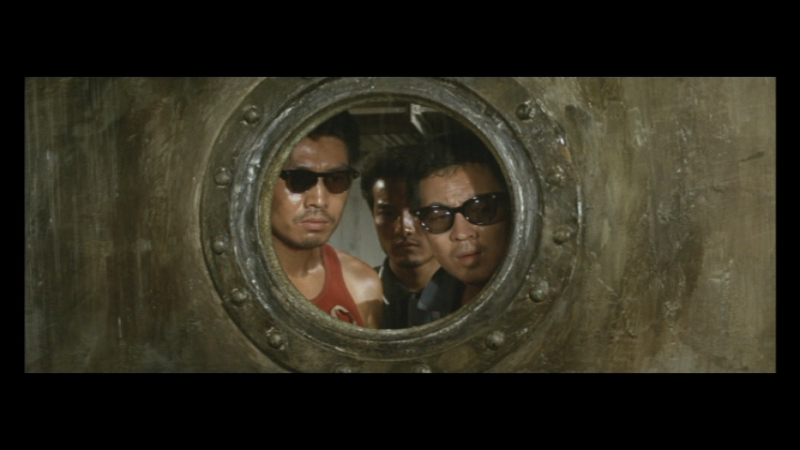 The supplies given to them by the ship's crew, would allow them to get by a little longer (as they reconciled themselves to starvation rather than giving into metamorphosis). After giving the crew thanks and a blessing, the man rows away. As he does so, a ray of early morning sunshine shows the crew that the man's story had been no delusion.
The supplies given to them by the ship's crew, would allow them to get by a little longer (as they reconciled themselves to starvation rather than giving into metamorphosis). After giving the crew thanks and a blessing, the man rows away. As he does so, a ray of early morning sunshine shows the crew that the man's story had been no delusion.
The script for Matango is, by comparison, cluttered, totally inconsistent and wildly melodramatic.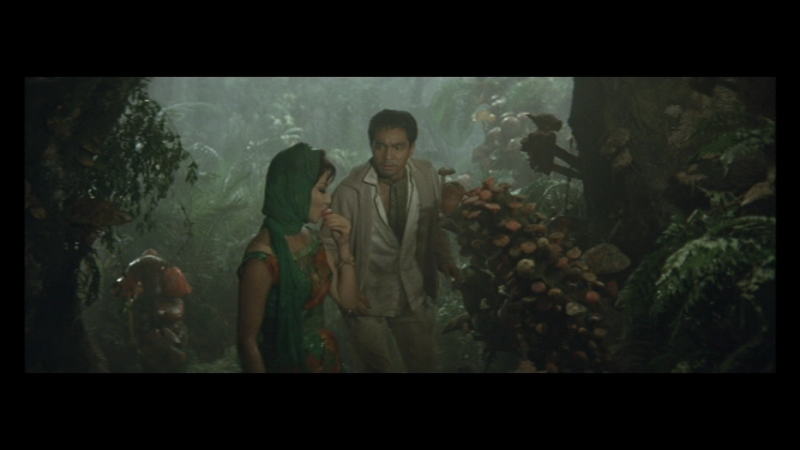 Here a yacht (with its male and female passengers and its crew) is pushed to an island by a mysterious current -- and once there, the ship is unable to leave. It is a large island, with clean running water and luxurious (normal) vegetation -- albeit apparently devoid of animal life. They find an abandoned ship, contaminated by some strange fungal growth and also encounter some large patches of fungus in the depths of the island's forest. The castaways start running out of food quickly (despite some canned goods left on the other ship, shellfish near the shore and a patch of garden near the shore).
Here a yacht (with its male and female passengers and its crew) is pushed to an island by a mysterious current -- and once there, the ship is unable to leave. It is a large island, with clean running water and luxurious (normal) vegetation -- albeit apparently devoid of animal life. They find an abandoned ship, contaminated by some strange fungal growth and also encounter some large patches of fungus in the depths of the island's forest. The castaways start running out of food quickly (despite some canned goods left on the other ship, shellfish near the shore and a patch of garden near the shore). 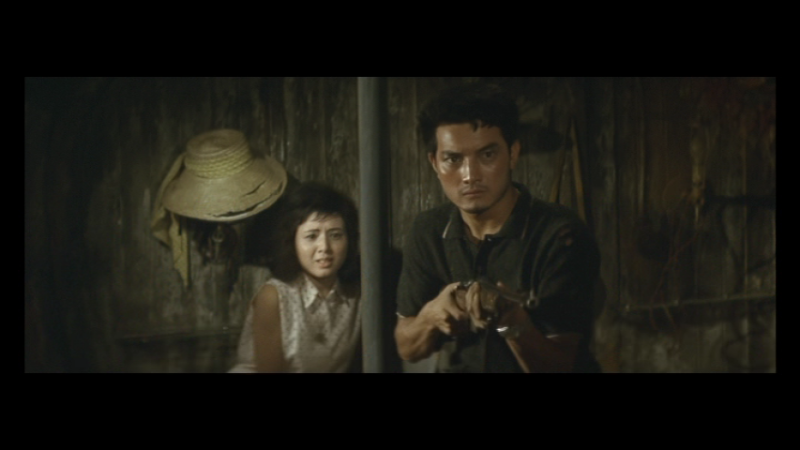 While sleeping on board the abandoned ship, which has been beached, they are bothered by what seems to be a mysterious prowler. Lust (and greed for food) causes all sorts of dissension (and some killings). Two of the most troublesome are driven away -- and discover that the fungus is delicious. Eventually only a man and a woman are left onboard. Despite incursions by strange wandering creatures, the two don't stick together -- so, of course, fungus people carry off the woman. The man finally discovers her in a fungal glade, surrounded by an array of weird creatures in various stage of fungus-hood (including the partially-transformed exilees).
While sleeping on board the abandoned ship, which has been beached, they are bothered by what seems to be a mysterious prowler. Lust (and greed for food) causes all sorts of dissension (and some killings). Two of the most troublesome are driven away -- and discover that the fungus is delicious. Eventually only a man and a woman are left onboard. Despite incursions by strange wandering creatures, the two don't stick together -- so, of course, fungus people carry off the woman. The man finally discovers her in a fungal glade, surrounded by an array of weird creatures in various stage of fungus-hood (including the partially-transformed exilees). 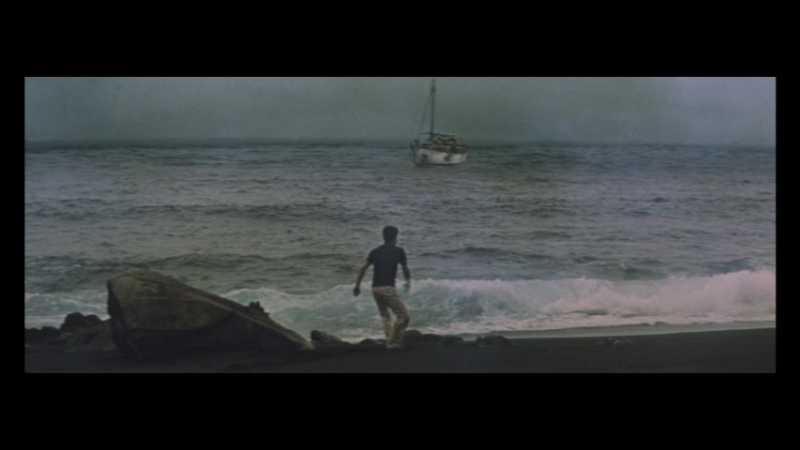 She too has decided that the fungus is irrestible and urges him to join her in eating it. He runs away in horror, finds the (original) boat useable and heads back towards civilization. This story is framed by the main character, returned to Tokyo and immured in an isolation ward in a hospital. He tells his story, but we never see his face -- until the last moments of the framing story at the end of the film.
She too has decided that the fungus is irrestible and urges him to join her in eating it. He runs away in horror, finds the (original) boat useable and heads back towards civilization. This story is framed by the main character, returned to Tokyo and immured in an isolation ward in a hospital. He tells his story, but we never see his face -- until the last moments of the framing story at the end of the film.
Honda does a good job of creating an eerie and foreboding atmosphere, despite the script's poor plotting, non-existent character development and clunky dialogue. He also makes the most of a largely so-so cast. The cinematography is often just serviceably functional, though some striking images can be found. I'm no expert on "special effects", but I assume these were well done for the era. My conclusion -- a better than average film of its genre, interesting but seriously flawed.
He also makes the most of a largely so-so cast. The cinematography is often just serviceably functional, though some striking images can be found. I'm no expert on "special effects", but I assume these were well done for the era. My conclusion -- a better than average film of its genre, interesting but seriously flawed.
Sweeney Todd: The Demon Barber of Fleet Street (Tim Burton, 2007)
While I did like this overall, I discovered, when trying to anlayze it after the fact, that I found more niggling flaws to note than virtues to extol. A catalog of those defects would give an inaccurate impression of my response to the film. The bottom line is that I am glad that a cinematically effective adaptation of a Sondheim musical has finally been made and, likewise, glad to have seen it -- once. I can't imagine ever feeling the need to see it a second time, however. Purely musically, I found this fairly inadequate, far inferior to the original broadway cast recording.
Seen at the theater, so no screen captures.
 The old Kino DVD of this film actually looked quite good (far better than older versions I had seen) but, though it had two musical scores, neither struck me as satisfactory. The new Kino DVD looks better --
The old Kino DVD of this film actually looked quite good (far better than older versions I had seen) but, though it had two musical scores, neither struck me as satisfactory. The new Kino DVD looks better --  and, perhaps more important, sounds vastly better, thanks to the reconstructed, newly recorded, original (1922) score of Hans Erdmann. This version of Nosferatu, or its British cousin (from Masters of Cinema), is an indispensable one for fans of Murnau and of "silent" cinema in general.
and, perhaps more important, sounds vastly better, thanks to the reconstructed, newly recorded, original (1922) score of Hans Erdmann. This version of Nosferatu, or its British cousin (from Masters of Cinema), is an indispensable one for fans of Murnau and of "silent" cinema in general. This is one of my favorite silent films (and one of my two favorite Murnau films, along with Last Laugh). The cinematography by Fritz Arno Wagner is, to my mind, unsurpassable. While the acting style is florid here, it certainly suits this material.
This is one of my favorite silent films (and one of my two favorite Murnau films, along with Last Laugh). The cinematography by Fritz Arno Wagner is, to my mind, unsurpassable. While the acting style is florid here, it certainly suits this material.  So much has been written about this film that any brief comments I can offer are essentially superfluous, however. More important by far are screen shots -- which I hope convince anyone who lacks a new improved version of this classic to rent or borrow a copy -- or better yet, buy one.
So much has been written about this film that any brief comments I can offer are essentially superfluous, however. More important by far are screen shots -- which I hope convince anyone who lacks a new improved version of this classic to rent or borrow a copy -- or better yet, buy one.http://i9.photobucket.com/albums/a59/mkerpan/murnau/nos/nos01.png
http://i9.photobucket.com/albums/a59/mkerpan/murnau/nos/nos02.png
http://i9.photobucket.com/albums/a59/mkerpan/murnau/nos/nos03.png
http://i9.photobucket.com/albums/a59/mkerpan/murnau/nos/nos04.png
http://i9.photobucket.com/albums/a59/mkerpan/murnau/nos/nos05.png
http://i9.photobucket.com/albums/a59/mkerpan/murnau/nos/nos06.png
http://i9.photobucket.com/albums/a59/mkerpan/murnau/nos/nos07.png
http://i9.photobucket.com/albums/a59/mkerpan/murnau/nos/nos10.png
http://i9.photobucket.com/albums/a59/mkerpan/murnau/nos/nos11.png
http://i9.photobucket.com/albums/a59/mkerpan/murnau/nos/nos12.png
http://i9.photobucket.com/albums/a59/mkerpan/murnau/nos/nos13.png
http://i9.photobucket.com/albums/a59/mkerpan/murnau/nos/nos14.png
http://i9.photobucket.com/albums/a59/mkerpan/murnau/nos/nos16.png
http://i9.photobucket.com/albums/a59/mkerpan/murnau/nos/nos17.png
http://i9.photobucket.com/albums/a59/mkerpan/murnau/nos/nos18.png
Matango / Attack of the Mushroom People (Ishirô Honda, 1963)
Perhaps it was unfair to Mr. Honda to watch his Matango the same week that I watched the newly restored Nosferatu.
 His (very loose) adaptation of William Hope Hodgson's 1907 story "The Voice in the Night" is certainly one of the best of Japan's vintage science fiction films of the 1950 and 1960s. And yet, Matango is not really competitive with the older "horror" film -- or with the story that inspired it.
His (very loose) adaptation of William Hope Hodgson's 1907 story "The Voice in the Night" is certainly one of the best of Japan's vintage science fiction films of the 1950 and 1960s. And yet, Matango is not really competitive with the older "horror" film -- or with the story that inspired it.Hodgson's story is simple but eloquent and narrowly focussed on telling its "incredible" story in a believable fashion.
 Hodgson tells of a ship, becalmed in the North Pacific, that encounters a man in a small boat, begging for food for himself and his wife. The man refuses to allow himself be seen clearly -- or to come on board the ship. At first suspicious, the crew decides to provide the help he requested,
Hodgson tells of a ship, becalmed in the North Pacific, that encounters a man in a small boat, begging for food for himself and his wife. The man refuses to allow himself be seen clearly -- or to come on board the ship. At first suspicious, the crew decides to provide the help he requested,  stirred by the urgency and sincerity of his tone. Food having been floated over to the man, he rows back to the isand where he and his wife are standed. Hours later, the man returns. He expresses gratitude and tells them that the two of them agreed that he should recount the story of their misfortunes.
stirred by the urgency and sincerity of his tone. Food having been floated over to the man, he rows back to the isand where he and his wife are standed. Hours later, the man returns. He expresses gratitude and tells them that the two of them agreed that he should recount the story of their misfortunes. The two were abandoned as the result of a shipwreck, left behind by the crew due to an insufficient supply of life boats. They floated (on a raft they made) to an island, but the island was almost entirely covered by some sort of lichenous growth -- lacking any sort of normal vegetation or animal life.
The two were abandoned as the result of a shipwreck, left behind by the crew due to an insufficient supply of life boats. They floated (on a raft they made) to an island, but the island was almost entirely covered by some sort of lichenous growth -- lacking any sort of normal vegetation or animal life.  They found a stranded ship offshore, but it too had been taken over by the lichenous growth -- and proved to be uncleanable. Luckily, they found a tiny patch of sandy beach that seemed resistent to the spread of the growth, but they still lacked a source of food (other than the supplies they had brought along and some canned good they found on the abandoned ship). Despite their best efforts to avoid contact with the lichenous contamination, they found that tiny patches of lichen had begun to appear on their skin. When returning from fishing one day (with little to show for his efforts),
They found a stranded ship offshore, but it too had been taken over by the lichenous growth -- and proved to be uncleanable. Luckily, they found a tiny patch of sandy beach that seemed resistent to the spread of the growth, but they still lacked a source of food (other than the supplies they had brought along and some canned good they found on the abandoned ship). Despite their best efforts to avoid contact with the lichenous contamination, they found that tiny patches of lichen had begun to appear on their skin. When returning from fishing one day (with little to show for his efforts),  he found his wife had tried eating fungus due to her dire hunger. While wandering long a path through the island's "forest", he encountered a strange creature that seemed to be almost entirely made of fungus -- and realized the ultimate fate that awaited his wife and himself, if they were to continue eating the lichenous growth. The couple had resolved not to eat any more of the apparently addictive substance, but had now run out of food.
he found his wife had tried eating fungus due to her dire hunger. While wandering long a path through the island's "forest", he encountered a strange creature that seemed to be almost entirely made of fungus -- and realized the ultimate fate that awaited his wife and himself, if they were to continue eating the lichenous growth. The couple had resolved not to eat any more of the apparently addictive substance, but had now run out of food.  The supplies given to them by the ship's crew, would allow them to get by a little longer (as they reconciled themselves to starvation rather than giving into metamorphosis). After giving the crew thanks and a blessing, the man rows away. As he does so, a ray of early morning sunshine shows the crew that the man's story had been no delusion.
The supplies given to them by the ship's crew, would allow them to get by a little longer (as they reconciled themselves to starvation rather than giving into metamorphosis). After giving the crew thanks and a blessing, the man rows away. As he does so, a ray of early morning sunshine shows the crew that the man's story had been no delusion.The script for Matango is, by comparison, cluttered, totally inconsistent and wildly melodramatic.
 Here a yacht (with its male and female passengers and its crew) is pushed to an island by a mysterious current -- and once there, the ship is unable to leave. It is a large island, with clean running water and luxurious (normal) vegetation -- albeit apparently devoid of animal life. They find an abandoned ship, contaminated by some strange fungal growth and also encounter some large patches of fungus in the depths of the island's forest. The castaways start running out of food quickly (despite some canned goods left on the other ship, shellfish near the shore and a patch of garden near the shore).
Here a yacht (with its male and female passengers and its crew) is pushed to an island by a mysterious current -- and once there, the ship is unable to leave. It is a large island, with clean running water and luxurious (normal) vegetation -- albeit apparently devoid of animal life. They find an abandoned ship, contaminated by some strange fungal growth and also encounter some large patches of fungus in the depths of the island's forest. The castaways start running out of food quickly (despite some canned goods left on the other ship, shellfish near the shore and a patch of garden near the shore).  While sleeping on board the abandoned ship, which has been beached, they are bothered by what seems to be a mysterious prowler. Lust (and greed for food) causes all sorts of dissension (and some killings). Two of the most troublesome are driven away -- and discover that the fungus is delicious. Eventually only a man and a woman are left onboard. Despite incursions by strange wandering creatures, the two don't stick together -- so, of course, fungus people carry off the woman. The man finally discovers her in a fungal glade, surrounded by an array of weird creatures in various stage of fungus-hood (including the partially-transformed exilees).
While sleeping on board the abandoned ship, which has been beached, they are bothered by what seems to be a mysterious prowler. Lust (and greed for food) causes all sorts of dissension (and some killings). Two of the most troublesome are driven away -- and discover that the fungus is delicious. Eventually only a man and a woman are left onboard. Despite incursions by strange wandering creatures, the two don't stick together -- so, of course, fungus people carry off the woman. The man finally discovers her in a fungal glade, surrounded by an array of weird creatures in various stage of fungus-hood (including the partially-transformed exilees).  She too has decided that the fungus is irrestible and urges him to join her in eating it. He runs away in horror, finds the (original) boat useable and heads back towards civilization. This story is framed by the main character, returned to Tokyo and immured in an isolation ward in a hospital. He tells his story, but we never see his face -- until the last moments of the framing story at the end of the film.
She too has decided that the fungus is irrestible and urges him to join her in eating it. He runs away in horror, finds the (original) boat useable and heads back towards civilization. This story is framed by the main character, returned to Tokyo and immured in an isolation ward in a hospital. He tells his story, but we never see his face -- until the last moments of the framing story at the end of the film.Honda does a good job of creating an eerie and foreboding atmosphere, despite the script's poor plotting, non-existent character development and clunky dialogue.
 He also makes the most of a largely so-so cast. The cinematography is often just serviceably functional, though some striking images can be found. I'm no expert on "special effects", but I assume these were well done for the era. My conclusion -- a better than average film of its genre, interesting but seriously flawed.
He also makes the most of a largely so-so cast. The cinematography is often just serviceably functional, though some striking images can be found. I'm no expert on "special effects", but I assume these were well done for the era. My conclusion -- a better than average film of its genre, interesting but seriously flawed.Sweeney Todd: The Demon Barber of Fleet Street (Tim Burton, 2007)
While I did like this overall, I discovered, when trying to anlayze it after the fact, that I found more niggling flaws to note than virtues to extol. A catalog of those defects would give an inaccurate impression of my response to the film. The bottom line is that I am glad that a cinematically effective adaptation of a Sondheim musical has finally been made and, likewise, glad to have seen it -- once. I can't imagine ever feeling the need to see it a second time, however. Purely musically, I found this fairly inadequate, far inferior to the original broadway cast recording.
Seen at the theater, so no screen captures.
Comments
I must say that restoration of the original tinting here makes a tremendous difference. I found this far more impressive tinted than monochromatic (not that the untinted version was not also fascinating).